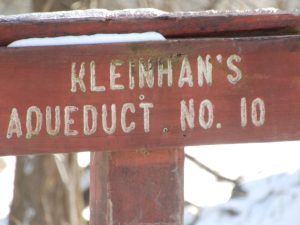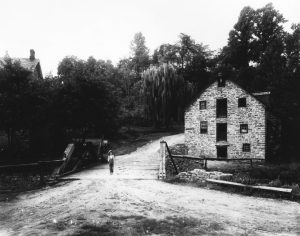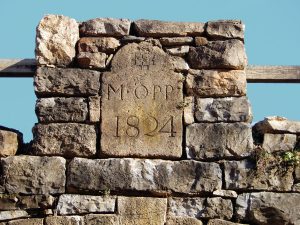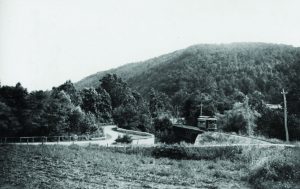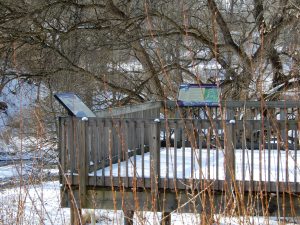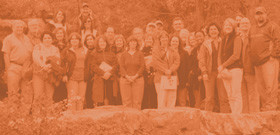The D&L Blog

An Early American Mill Village in the D&L Corridor
There are at least three places in Pennsylvania called Coffeetown. There’s one in North Whitehall
Township, Lehigh County. Another in North Londonderry Township, Lebanon County. And one in
Williams Township, Northampton County. All three of these Coffeetowns were once bustling little
villages, with their own industries, commerce, residents, schools, churches and post offices. Today, all
three are historical place names of bygone hamlets, relics of the distant past. It’s the Coffeetown in
Williams Township, Northampton County, that’s the focus of this blogpost.
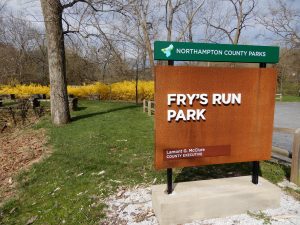
Coffeetown is located in the Delaware Canal Region of the D&L National Heritage Corridor, about seven miles south of Easton. Situated off PA 611 (South Delaware Drive) near the confluence of Fry’s Run and the Delaware River, what remains of Coffeetown today lies between Royal Manor and Coffeetown roads in Williams Township. Yesteryear’s lower end of town is today’s Fry’s Run County Park, which encompasses five acres of woodlands and meadow, bisected by Fry’s Run—a High Quality, Class A Wild
Trout Stream.
Several years ago, Northampton County Parks collaborated with the D&L Corridor, the Delaware River Greenway Partnership, and Williams Township Historical Society on an educational outdoor wayside exhibits project to celebrate the history and heritage of Coffeetown at Fry’s Run Park. Park Management Plans had long called for visitor interpretation of this early American mill village and the historic relics of a stone arch bridge and trolley trestle that span the creek here. The project culminated last year with the installation of two beautiful 36”x48” exhibits that are now mounted on the wooden deck that overlooks Fry’s Run and the historic village commons of Coffeetown at Fry’s Run Park.
Legend has it that Coffeetown was so named because several women in the area were experts at mixing
and roasting various local grains as a substitute for store bought coffee, which was hard to find in early
rural America. In 1901, Milton Rice, a Coffeetown resident and local schoolteacher, wrote of his
hometown in the Doylestown Intelligencer, “The name Coffeetown is applied to a district, rather than a
town, which lies nestled among the hills of southern Northampton County, in such a way as to suggest to
the mind that famous work of Washington Irving, The Legend of Sleepy Hollow.” Coffeetown’s
enchanting setting, with its babbling brook and bucolic landscape, is indeed reminiscent of upstate New
York’s Sleepy Hollow.
The stream that runs through Coffeetown was named after William Fry, the first recorded landowner here in 1730. Fry’s Run was once known as Kleinhans Creek, so called after the Kleinhans family, who were also early residents here. The aqueduct that carries Delaware Canal over Fry’s Run is still known as
Kleinhans Aqueduct to this day.
Coffeetown industries ran on water. Fry’s Run turned waterwheels that powered grindstones in gristmills and saws in lumber mills, including the first mill built here — a sawmill on the south side of the creek at today’s Fry’s Run Park. George Kleinhans built the sawmill here in 1762. The park was once part of Kleinhans Common, a commercial green that included the sawmill and a lumberyard. A gristmill was soon built upstream from Kleinhans sawmill. About 1840, a second gristmill was built upstream of the
first one. Around these mills grew the little village of Coffeetown.
By the late 1800s, Coffeetown was in its heyday. The village consisted of a gristmill, sawmill, creamery, metal bending factory, blacksmith shop, store, school, tavern, hotel, post office, church, about 25 homesand around 175 residents. Trade on the Delaware Canal and stagecoach traffic on River Road at the east end of the hamlet, as well as nearby farming, iron ore mining and limestone quarrying also supported Coffeetown’s commerce.
However, with the coming of the automobile, electricity and decline in canal commerce, Coffeetown’s businesses started to become obsolete in the early 20th century. Local residents and businessmen could drive to urban centers to buy or sell what they needed. In 1927, the original Kleinhans gristmill closed after 165 years of service. It was converted to a fertilizer factory until it was shuttered for good in 1947, bringing to an end the last of Coffeetown’s industry.
Bridges to History at Coffeetown
Seven years after River Road (today’s PA 611/South Delaware Drive) was built through Williams Township in 1817, a stone arch bridge was constructed over Fry’s Run in 1824 as a permanent replacement for an earlier crossing. This is the oldest bridge in Northampton County and one of the oldest bridges anywhere along today’s D&L National Heritage Corridor. Michael Opp was a county commissioner, treasurer and a member of a committee appointed to research and develop the bridge that bears his name on its date stone.
In 1921, the state highway department realigned River Road where it crossed Fry’s Run and built a concrete bridge next to the stone arch bridge, forever cutting it off from vehicular traffic. PA DOT replaced the 1921 bridge in 2011. Today, the 198-year-old stone arch M. Opp Bridge provides a pedestrian crossing and lovely views over the creek at Fry’s Run Park.
In 1904, the Philadelphia & Easton Railway Company completed its 32-mile trolley line between Doylestown, Bucks County and Easton, Northampton County. The tracks crossed Fry’s Run on a steel truss trolley bridge just upstream of the stone arch River Road Bridge. The P&E Railway called its scenic riverside line “The finest Trolley Ride in Pennsylvania” and “The Road of Wild Roses.” Eventually, the rise of affordable automobiles made the intercity trolley obsolete. The Doylestown to Easton trolley made its final run on Thanksgiving Day in 1926.
The two colorful 36”x48” outdoor exhibits that interpret the cultural landscape history of Coffeetown are mounted on the wooden overlook deck at Fry’s Run Park for public benefit and education. The deck itself is built on one of the two piers that supported the iron trolley trestle that once spanned Fry’s Run.
The overlook deck is perched high above the creek, affording beautiful views of the stream valley below and the historic stone arch bridge just downstream. Traces of Kleinhans 1762 gristmill and milldam are all that remain of the once busy, noisy commercial stream corridor at today’s quiet, peaceful Fry’s Run
Park.
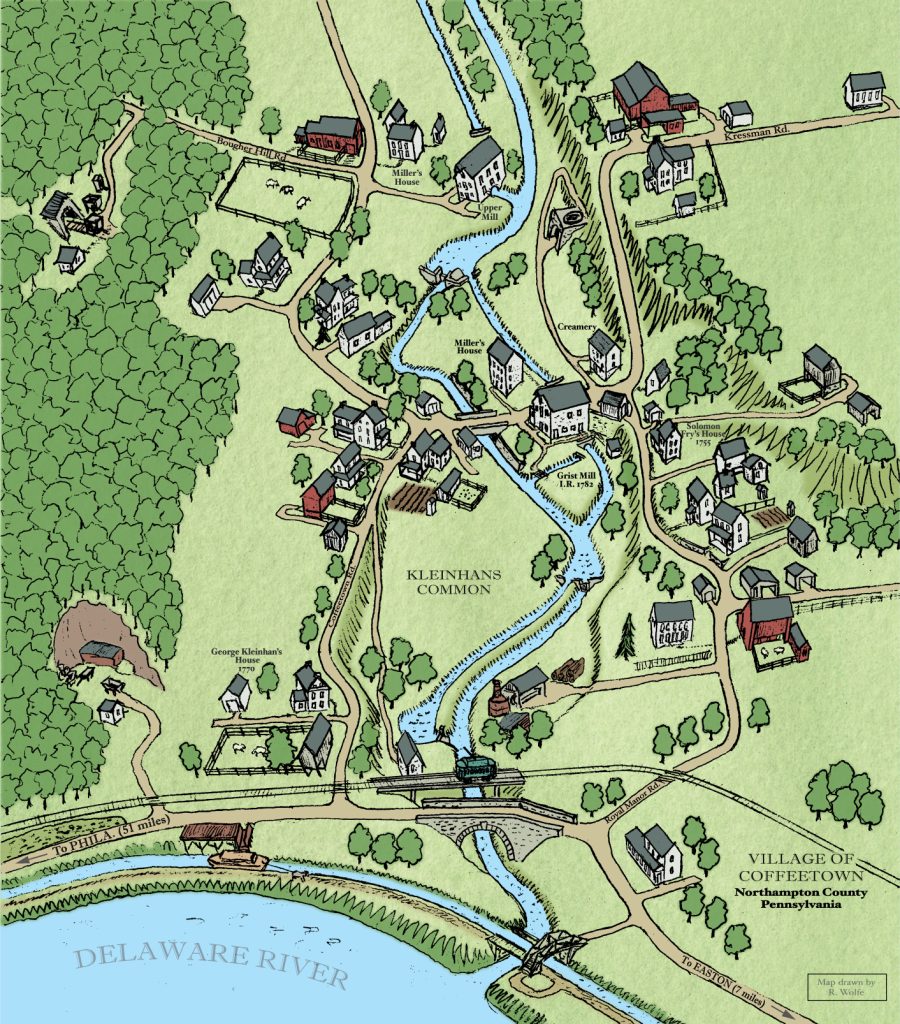
Blog Post by: Jim Wilson, Parks Recreation Specialist, Northampton County Division of Parks &
Recreation

